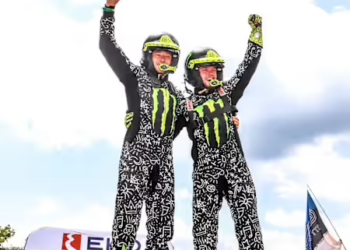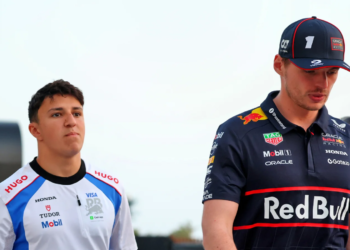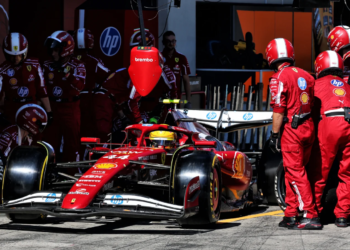Dominance for Daniel Ricciardo amid power drama, a lesson for Max Verstappen, and what to do about a procession. Motorsport Week presents its conclusions from the Monaco Grand Prix.
Ricciardo wins it the hard way
Daniel Ricciardo has become synonymous with swashbuckling displays of opportunism in his Formula 1 career, snatching a half-chance and turning into the biggest trophy, so it was perhaps little surprise that what should have been a straightforward lights-to-flag victory was a nervy affair.
Ricciardo’s previous six wins had all come from lower than third on the grid – but from the outset of the long Monaco weekend he outlined his credentials, regularly posting new track records as he glided his Red Bull RB14 around the Principality’s historic streets.
Having put himself in strong position to win by staying out of trouble in practice and qualifying – never the simplest task, as Max Verstappen can testify – Ricciardo controlled the start and preserved his Hypersoft tyres while edging clear of primary opponent Sebastian Vettel, the gap opening to four seconds. Once Vettel and Lewis Hamilton had made their sole stops, discarding Hypersofts for Ultrasofts, Ricciardo duly did the same – and mercifully this time Red Bull had sufficiently prepared the rubber.

But then the MGU-K failure struck and Ricciardo was robbed of around 160bhp – meaning he did not use seventh or eighth gear – while the knock-on effect was overheating rear brakes, requiring the balance to be pushed forwards by around six or seven per cent, a huge alteration compared to the usual one or two per cent tweak. All while negotiating Monaco’s tortuous streets, while trying to save tyres, and in the full knowledge that there were still 50 laps left to run and, oh, by the way, Vettel is now in your rear-view mirrors. That Ricciardo not only stayed cool under pressure but also expertly managed the problem, adapting his driving style in the process, was a testament to his skill as he staggered onlookers and his own Red Bull team. Ricciardo is known as an opportunist pass-master but this was race management of the highest level as he deservedly carved his name into the list of Monaco victors. It was also redemption for 2016, while Race Engineer Simon Rennie, too, deserves credit for concisely informing his driver of the issues while providing supportive motivation throughout.
“I mean, he could have been in Apollo 13, I tell you, with the way he was dealing with the issues,” said boss Christian Horner. Parking Ricciardo’s car was a seriously considered option in some quarters at Red Bull but senior management on the pit wall doggedly refused to accept such a thought. “Our reliability engineers are looking at saving the components to avoid penalties at future races,” said Horner. “So it was like, okay we are likely to ingest a whole bunch of shrapnel from the MGU-K so we should stop the engine, but I said no let’s keep running and if it stops it stops, we are leading the Monaco Grand Prix. I discussed it with Adrian [Newey] and he was in total agreement that we go until it smokes.
“It was important for [Ricciardo] to keep his cool, keep track position, don’t kill the tyres, don’t kill the brakes, don’t kill the engine and bring it home. He has been so focused since he arrived here this weekend there was no way he was going to let this victory slip through his fingers.”
Ricciardo was advantaged by the fact that the reliance on power in Monaco is reduced and the shorter wheelbase of the RB14 aided tyre preservation in a race that was tyre-limited, but even so, it was a drive to go down in history, and fully, utterly deserved. He topped FP1, FP2, FP3, Q1, Q2, Q3, led all 78 laps and won – a display of dominance rarely witnessed in Formula 1.
Max learns a lesson… perhaps

While Ricciardo gracefully flopped into Red Bull’s Energy Station pool, the occupant of the other RB14 was left to reflect on a difficult weekend. Verstappen had finished a close runner-up to Ricciardo in each practice session and a front-row starting position was a near-certainty, but Verstappen threw it all away with a near-identical crash to his costly 2016 mistake, the crash damage resulting in a gearbox leak that could not be repaired pre-Q1. A downbeat Verstappen accepted responsibility and Red Bull chiefs urged him to learn his lesson. When the MGU-K failure that manifested itself in Ricciardo’s car is taken into consideration there’s every real possibility that Verstappen could have been the triumphant Red Bull driver, but he squandered his golden chance with a minor misjudgement that had major ramifications – though in Monaco it only needs to be a small mistake, and Verstappen, by now, should have that awareness. There is no requirement to push to the absolute limit in a practice session, particularly not with just a two-hour window prior to qualifying. Verstappen is clearly an exceptionally talented driver but the list of transgressions – both in previous years in Monaco and his 2018 season – makes a compelling case for the prosecution that is difficult to ignore. It is frustrating to witness a talented driver clearly rushed up the ladder, skipping the crucial building blocks in junior categories that his rivals were able to experience away from the intense spotlight, and it is proving costly for both Verstappen and Red Bull. This should have been a 1-2 for Red Bull. For what it’s worth, Verstappen’s race drive was very good, as he calmly and coolly picked off rivals, stayed out of trouble, and sagely collected a pair of points. The sight of Ricciardo spraying the champagne, though, will resonate more.
“I think he has a very good teacher in the car next door to him,” said Horner. “Max has an abundance of talent and had some harsh lessons this year and I think a modified approach will benefit him. Of course [we’ve talked to him]. But you’re going to get a thousand different opinions and the only person who can address it and deal with it is Max. This weekend was very painful for him. Max arrived in F1 very quickly so he is doing his learning in a very public arena and is in a front running car very quickly. Most guys would have gone through some of this in the lower formulas that you wouldn’t have even seen, whereas he is having to deal with it in a very public arena. I’m sure he will emerge from it on the other side.”
Procession party

It is fair to say that the Monaco Grand Prix – while tense throughout amid Ricciardo’s problem – was not a thriller. But then Formula 1 veers towards a tendency in being hyper-critical towards a less-than-stellar event in a manner unmatched by other sports. Tedious 0-0 draws happen in football, straightforward wins occur in tennis, rugby and cricket: not every event can have wall-to-wall action. Nonetheless, if people are searching for improvements, what can be done? One element is certainly the World Feed broadcast, with Monaco the only event to be directed by the local producers as opposed to Formula One Management. It is a testament to the excellence of the usual F1 TV crew that the pictures presented to global viewers in Monaco were sub-par, missing action, and frequently cutting away from enticing scraps or important moments. The Monaco Grand Prix is a brutal assault on the senses and it is scarcely believable when witnessed up close. But if that doesn’t translate on TV then the magic gets lost and the allure weakens – and that, more than anything, is a crying shame. Another idea, suggested by Lewis Hamilton, is to modify the circuit – though that is easier said than done. Monaco has enough streets, and is planning to build more by reclaiming land from the sea by the exit of Portier, but whether any of them can logistically be used – and whether it would have any impact on the racing – is another matter altogether. “I said to Prince Albert the other day maybe it’s time to make it longer,” said Hamilton. “We are doing 1:11s around here, there’s more roads. Do we change this great track and make it even better? Maybe it’s got to be a different format, something here.” Though through all of this it must be noted that this is the Monaco Grand Prix – it is, and has typically been, processional. A lack of overtaking is nothing new, but it has merely been accentuated by faster and wider cars, further reducing the scope for getting side-by-side and lessening the braking zones too.
Taking the chances, missing the boat

This was another event in which the midfield battles were decided on small margins. Esteban Ocon was sixth throughout practice and qualifying, but sixth to 10th on the grid featured four different teams that were covered by just two-tenths of a second. Over at Toro Rosso, the fortunes of its drivers were starkly contrasted, as Pierre Gasly executed a fine drive while Brendon Hartley’s season is becoming Gutierrez-at-Haas-esque as more minor setbacks added up. Gasly used the experience from his GP2 days, in which he had to mould his driving style to avoid excessive tyre degradation, to run a stunningly long first stint on Hypersofts, an approach that netted him two positions. It means he now sits pretty on 19 points and is proving very adept at grasping the chances that come his way when Toro Rosso’s inconsistent package is at its high peak. Hartley, meanwhile, was seventh in the final practice session but a so-so first Q1 lap left him requiring a second hot lap, and that chance was scuppered when Charles Leclerc went wide and brought out the yellow flags. That effectively wrecked Hartley’s weekend, but a time penalty for speeding in the pits in the race hurt his prospects further, though he was completely blameless in the incident that brought his race to a premature conclusion. Renault scored a double top 10 finish as its drivers swapped places in race trim, Nico Hulkenberg profiting from his Q2 exit to jump tyre-struggling team-mate Carlos Sainz Jr., who only narrowly fended off Sauber’s Marcus Ericsson. The Swede was a little peeved to be the first driver to miss a point, but encouraged again at the pace of the C37, correctly asserting that Sauber now has to stop approaching each weekend as the underdog and realise that it has now truly returned to the midfield.
Abject, your honour

Haas had been the standout midfield player in Barcelona while McLaren had scored points at each Grand Prix, but both suffered a dismal time in Monaco. Haas suffered technical problems in Thursday’s first practice session and its pace never picked up, with Kevin Magnussen slowest of the 19 qualifiers and Romain Grosjean the tardiest in Q2, with his penalty hangover relegating him further. Haas just lacked pace. McLaren, meanwhile, was set for seventh courtesy of Alonso until his transmission failed, providing the beautifully ironic picture of the Honda-powered Toro Rosso cruising past the stricken MCL33 to pick up the pieces. Stoffel Vandoorne was hampered by a gearbox setting issue that was unable to be amended in time for qualifying while in race trim he suffered from higher-than-expected tyre wear and slipped to a disappointing 14th. With the similarly-powered Red Bull triumphant, it merely emphasised the long road to recovery and respectability still faced by McLaren. And if Haas and McLaren had a shocker, then spare a thought for Williams. Sergey Sirotkin’s promising weekend was undone by his tyres not being fitted prior to the three-minute mark while Lance Stroll twice sustained a puncture that was caused by hot brakes overheating the rim. The team’s freefall shows little sign of abating.
Home town hero can’t catch a brake
Charles Leclerc wasn’t quite the face of the Monaco Grand Prix, but he wasn’t far off. Having grown up in the Principality he was understandably the focus of local attention, even if some well-wishers weren’t fanatical F1 fans, questioning him as to why he wasn’t competing for pole! Nonetheless, his face was on posters, in papers and there was even a bus route re-named in his honour. Leclerc also took the opportunity to honour his late father, Herve, who competed in the F3 race 30 years ago, by sporting his helmet colours, while there was also a tribute to his godfather and mentor Jules Bianchi, whose sole F1 points came at the event four years ago. Unfortunately a left-front brake disc failure left Leclerc powerless to prevent a rear-end collision with Hartley, but he was circumspect afterwards as he chilled out with friends and family at Sauber’s motorhome before migrating across to the nearby Stars ‘N’ Bars restaurant.
Strike one, strike two
The Monaco Grand Prix is Formula 1’s jewel in the crown but the balconies were hardly rammed, with some grandstand seats still vacant, and a general sense of 2018’s running being a quieter-than-usual event. Monaco’s geographical position – surrounded by France and the Mediterranean Sea – also means access is reliant on France, and that caused frustration for many paddock folk amid the country’s ongoing series of strikes. Air traffic control strikes in the build-up, and on Sunday, caused flights to be cancelled or delayed, while railway workers also triggered industrial action across the weekend, impacting on paddock and fans who had opted to use the railway to travel in from nearby towns and cities, such as Nice, with the service severely disrupted. Still, it’s a good job the F1 fraternity won’t be back in this part of the world in around four weeks’ time…






